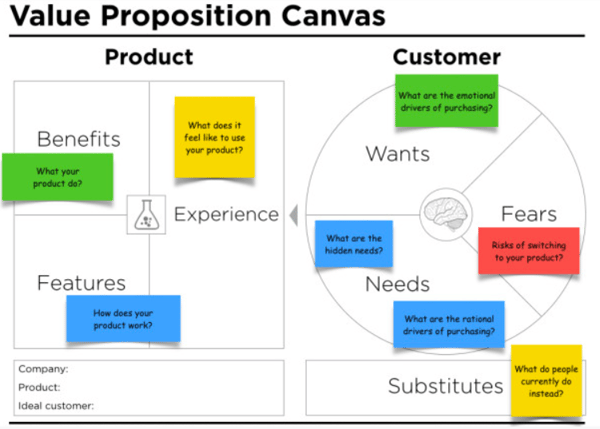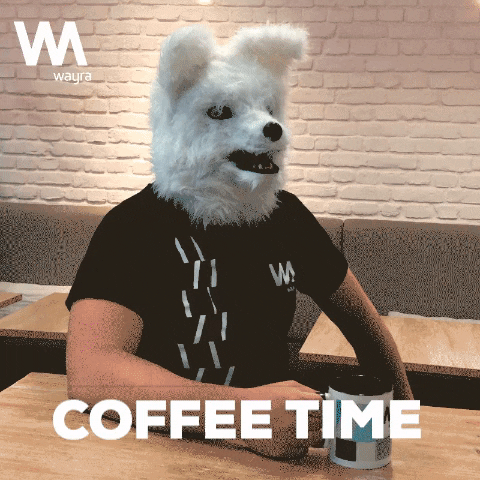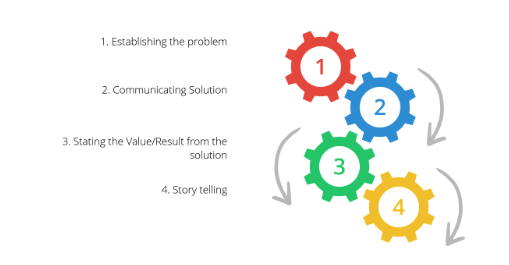After the short and more introductory articles on how to approach your potential clients in general, this piece now focuses on the specific needs you could address with your solution. One startup sales strategy in 2019 is value-based selling, where you define your value proposition for each type of customer. Your value proposition should be based on your validated hypothesis about your solution (see Customer Discovery). All the different customer groups (or better Startup Personas) need to see the value in your solution, how it differs from your competitors or just how it makes their life easier.
The Value Proposition focuses on the overall benefit of your product, not on your features, which only should deliver the value. It clearly addresses the problem and can define, how and why your solution differs from the market.
Additionally, you may have not only one value proposition, but rather various sets value propositions for different target audiences and personas. It is essential to be addressed clearly and in the customer’s words.
This guide focuses on the sales process. So when talking to your prospects and addressing them with the relevant material, you need to individually define what is useful and valuable for them. The findings from this process can surely be used for marketing material to support your sales story and meetings.
Creating a Value Proposition for your Startup
A value proposition is where the offer of your company (your product) meets the desires of your customers. It is the overlap between what you make and why people buy, that is why it is really important to build the best value proposition, in order to show the customers there is more add value on your offer than on any other existing product in the market.
The value proposition is nothing about how many features your product has, it has to be about how much value your customers can identify on your product.
We will present in this guide two methods to define your value proposition but it is important to know that any canvas that helps you understand your customer, your offer and how the two fit together will help you clarify your value proposition. It is the moment where you realize if you have enough information about your potential customer. If you feel at some point that you are running out of information to answer, take your bag and go outside to ask your potential customer about it.
Value Proposition Creation Method #1: The Canvas
The version of the Value Proposition Canvas created by Peter J. Thomson leads Startups to examine the human experience of their customers and to think through their customer experience.
The product section uses features and benefits with the addition of experience. The product understanding sections include:
- Features as the description of how your product works. The features are the functioning attributes of your product.
- Benefits as what your product does for the customer. The benefits are the ways that the features make your customer’s life easier by increasing pleasure or decreasing pain. The benefits of your product are the core of your value proposition. The best way to list out the benefits of your product is to imagine all the ways that your product makes your customer’s life better.
- Experience as the product experience is the way that owning your product makes the customer feel. It’s the sum total of the combined features and benefits. Product experience is different to features and benefits because it’s more about the emotional reasons why people buy your product.
The customer section draws on neurolinguistic programming and psychology research into motivation. It focuses less on “pains” and “gains” because people can be motivated by both pains and gains in different ways. The customer empathy sections include:
 Diagram to help your startup discover its value proposition
Diagram to help your startup discover its value proposition
- Wants – The emotional drivers of decision making are things that we want to be, do or have. Our wants are usually conscious (but aspirational) thoughts about how we’d like to improve our lives. The wants addresses more to the pull of our hearts and our emotions.
- Needs – The customer’s needs are the rational things that the customer needs to get done. Interestingly, needs are not always conscious. Customers can have needs that they may not know about yet. Designers call these “latent needs“.
- Fears – The dark side of making a decision is that it carries fear. Fear of making a mistake, fear of missing out, fear of loss and dozens of other related fears. Fears can be a strong driver of purchasing behavior and can be the hidden source of wants and needs. Customer fears are often the secret reason that no one is buying your widget.
- Substitutes – These aren’t the obvious competitors, instead look for the existing coping behaviors. This is on the canvas because it shocks us into remembering that our customers are real people with daily lives who have made it this far in life without our product. No matter how much better your product is than the competition, if it isn’t better than the existing solutions then you don’t have a real-world value proposition.
A key finding from the process of mapping a value proposition is often “we don’t have enough information to answer this section”. That is a perfect moment to adopt a lean startup approach and to get out of the building to ask existing customers and potential customers about their wants, needs, and fears. This is important to see how many of your products offers overlap with what your customers want. But during this process, you will find many wants that the products can't satisfy and you maybe should think of modifying it so your clients feel understood.
Applying the Value Proposition Canvas
So, how can I make use of this canvas?. Let’s say your startup called Weckify wants to sell a smart alarm clock.
- Features: Alarm clock, natural light, music speakers, Spotify integration, phone charging
- Benefits: The current alarm is essential for waking up, the natural light makes it more pleasant, while the music speakers in combination with the Spotify integration even increases the pleasure giving you a variety of musical options to be awakened to. In addition, the good speakers as the music capabilities make Weckify a smart speaker beside the alarm features to be used all day long. With the option to charge your phone it even declutters your nightstand. Instead of having an alarm clock, a light, and a charger, you have it all in one gadget. Weckify decreases the pain of waking up in the morning.
- Experience: Weckify makes you feel rested, relaxed and happy – even right in the morning
Now let’s switch to the customer site. As the proposed startup is fictional, we don’t have any customers to observe, the information cannot be derived from actual behaviour. Additionally, we have to think about the different groups of customers, that can be addressed with the product and therefore with the value proposition. As every group of customers has got their specific needs and emotions, it is good to create buyer personas for you to focus on and make them specific. Customers for a smart alarm clock could be stressed parents wanting to start their day right, entrepreneurs, students, old people or even pupils. For our example, we interviewed three persons: a pupil, a father, and an entrepreneur.
Pupil

The tones of my mobile phone to wake up are really annoying but using my favourite song is also a bad decision because after some time of having it as the tone of my alarm clock I always end up hating it and I never want to listen to this song again. I like the feature of having an alarm clock with natural light but what about if I am sleeping outdoors? Having an alarm clock with vibration mode would also be a good idea. I do not know if only a Spotify integration is a good idea because there are also many people who do not use it but other streaming services. It would be good to have a power bank or a USB port as features for the alarm clock devise. Currently, I always use my phone as an alarm clock, it is really useful because I always have it with me. It would also be cool if the device could have a pocket for my glasses, approximately half of the German population wear glasses or have always headphone with them. In terms of the prices, I would pay a maximum of 50 Euros if it is more expensive, I would ask my parents to give it to me as a gift.
Wants (Emotional drivers) (Gains)
- It is always possible to get awakened
- Having many devices in one
- Fair price (max 50 Euros)
- Technological device
Needs (Rational drivers) (job to be done)
- Vibration function
- Linked to a mobile phone app
- Power bank extra function
- USB port extra function
- Pocket for glasses or headphone
- Spotify linked to the alarm clock
Fears (Pains):
- Tones are annoying
- Gets tired of my favourite song by having it as alarm tone
- Not being woken up at all
Substitutes: Mobile phone alarm clock
Father

I always use my phone as an alarm clock or I usually ask my wife or my kids to wake me up. I don't really like alarm clocks because they are annoyed. I would like to wake up feeling relaxed. It would also be good it the alarms do not get me away suddenly, going slowly with the process of waking up would be better. I do not like the fact that alarm clocks are not suitable for traveling.
Wants (Emotional drivers) (Gains)
- Arriving on time
- Feeling good while waking up
- Everywhere useful
- Getting awakened by myself
- Needs (Rational drivers) (job to be done)
- Chance to have a low tone (not that noisy)
- An alarm clock able to be used outdoors.
Fears (Pains):
- Having an irritating process of waking up
Substitutes: Mobile phone alarm clock, partners, children
Entrepreneur

I would really like to have my alarm clock linked to my Smartwatch. It would be really good because it could wake me up for example after my slow-wave sleep phase. Once you go to the bedroom, all your wishes are fulfilled, you know where your things are. Night's sleep starts with going to bed and ends with getting up that is why this process is really important for me. For me are also important the design and the accessories I could use with the device. Having the alarm clock linked to Spotify would be awesome but if it is really expensive I would care more about the design than the Spotify feature. Normally I use Alexa as my alarm clock with the Sonos beam as a speaker. Really important is my privacy protection I do not want another device linked to the cloud.
Wants (Emotional drivers) (Gains)
- Recognition among friends and colleagues
- Innovative device
- Good looking design
Needs (Rational drivers) (job to be done)
- To have an auto-wake up function that wakes you up after your slow-wave sleep phase.
- Linked to Spotify
- Privacy protection (not linked to the cloud)
Fears (Pains):
- Having a bad mood all day long Boring and old devices
Substitutes: Alexa and Sonos, Mobile Phone
This approach helps you to find a more strategic approach to the assets of your solution which are more communicable. Maybe by actually getting insights from the outside world and not your startup bubble, you find features, benefits or substitutes of your solution, that you have never thought about before. Maybe getting these insights will also set you back or shock you, but in the end, it is all about communication. One way to actually build a story around the features is the Value Communication Framework, which will be featured in the next article.
Describing the real value of your solution is one part when starting your operational sales. The next step is finding a way how to communicate it and make it easily digestible for your potential customers. For this, we take the Value Communication Framework, presented by Justin Withers, Vice President, Product Management and Product Marketing at DiscoverOrg.
The Value Communication Frameworks breaks down into four succeeding steps:

1 Establishing the problem.
Describing the problem effectively, making the problem vivid and tie a financial cost to the problem.
2 Solution
Communicating how your solution delivers key benefits.
- Features: What your product has
- Benefits: Explain the benefits of the features
- Differentiate: Why your product is different than all the other products in the market
Clients will only remember at the end of their customer journey, what the differentiation of your product is.
3 Value/Result from the solution
Communicating the tangible financial value that a customer would get from your solution
- Value drivers. What the customer gets and where the product will drive him to.
- Value/ROI. What does it mean for the client to buy in terms of money, savings, etc (in terms of $)
4 Storytelling
Incorporate the three steps above and mention a customer example where you say how this customer improved its life/operation with your product. Storytelling through a customer testimonial conveys undeniable value.
So, let’s apply it again to our aforementioned idea of Weckify.
1 Establishing the problem.
How often are you awakened by an alarm clock in the morning still being tired and feeling unrested? And what does that mean for your personal and professional life? You can’t focus on important tasks and work as efficient. You are tired the whole day and can’t enjoy the time with your family or friends as much as if you were well-rested. And still, you have to wake up every workday in the same unpleasant way at the same unpleasant time!
Solution
- With Weckify some of that may change! We offer you an all in one gadget for your nightstand! Weckify offers an alarm clock with Spotify integration and a source of natural light that serves at the same time as a music speaker and even a phone charger!
- The excellent speakers and the natural light improves the experience
of waking up and the Spotify integration gives you a wider range of musical options to be awakened to and makes it even less painful! Because of the good speaker and the music capabilities Weckify can also be used as a music speaker in the day time. In addition to that, it will de-clutter your nightstand tremendously because it charges your phone and operates as a light source as well!
Weckify is unique because it unites all the things you use in your nightstand on a daily basis in just one gadget while it also brings you a smoother waking up experience due to the changing music and natural light.
3 Value/Result from the solution
- While using Weckify you will be much more relaxed, rested and less tired! It will not only help you be happier in the mornings but also improve your mood all day long. You will be able to enjoy quality time with your friends and family more and be more present in these situations. Your efficiency at work will increase as well, causing you to get more out of the day and in the long term even more money. You will be having more fun doing the things that you love and more energy to say “no” to the things you don’t want to do.
- And it will only cost you around 300 € to get this life-changing allrounder, that will improve both your nights and your days!
4 Storytelling
Linda, one of our customers, is a great example of the life-changing effect of Weckify.
Before she owned a Weckify Smart Alarm Clock Linda was tired every day. She used to need three cups of coffee in the morning and would still be at her minimum efficiency at work. Her friends would be worried about her because she seemed to be absentminded quite often. But that changed when one of her friends recommended her to buy a Weckify Smart Alarm Clock.
She ended up buying one and connecting it with her Spotify-Account. The next morning she was awakened by comforting, but noticeable music and soft light. She was a little bit tired because it still was 6.00 am but way less than usual! The following day she felt relaxed, happy and fit. She had a great day at work and the meetup with her friend Sofie was more fun than she had in weeks. It was also convenient for her to use her Weckify as a music speaker, a lamp for nightly reading and a phone charger.
Since then she uses her Weckify Smart Alarm Clock every day and her nights, mornings and days got so much better!
The communication here may seem like an infomercial and funny at first sight, but it helps you condensing the information that really matters. You have to start at some point to plan your communication and your sales story, and exaggerating makes it at least more fun. How to build a sales story for your different target audiences will be featured soon.






/RootCamp_Logo-Ecosystem.png?width=200&name=RootCamp_Logo-Ecosystem.png)
/Bitroad_Logo-Ecosystem.png?width=200&name=Bitroad_Logo-Ecosystem.png)



/White%20Versions/stadt_leipzig_white.png?width=130&name=stadt_leipzig_white.png)
/lfca_white.png?width=119&name=lfca_white.png)

/White%20Versions/sachsen_signet_white.png?width=65&height=79&name=sachsen_signet_white.png)